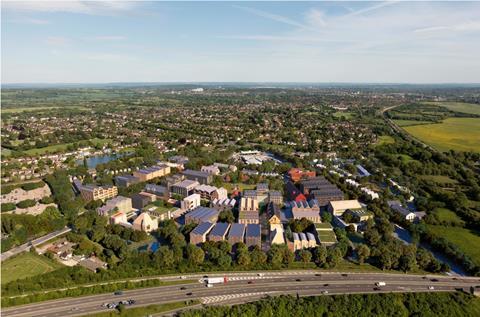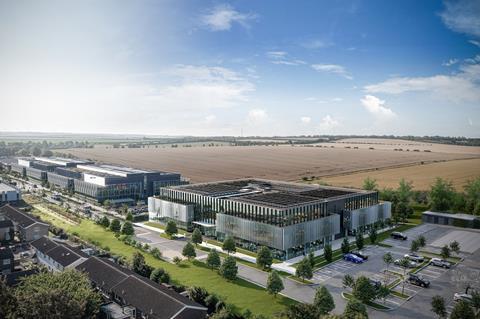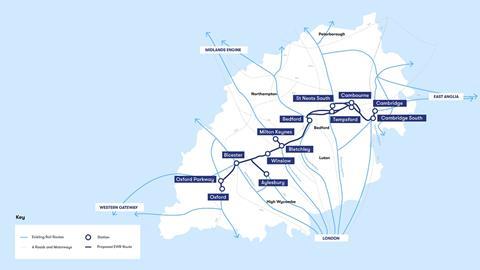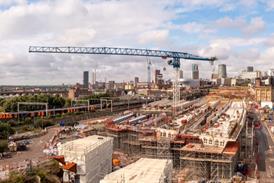The chancellor has given her backing to an expansion plan for the corridor connecting Oxford, Milton Keynes and Cambridge, including thousands of homes, which the previous government dropped. Joey Gardiner asks what hope the industry can have that Labour can stay the course

It did not take long for the backlash to begin. Even before chancellor Rachel Reeves had stood up to deliver the speech at which she announced her backing for a ŌĆ£growth corridorŌĆØ between Oxford and Cambridge, the Daily Telegraph was already reporting the fears of residents in the corridor that the plans will ŌĆ£wipe us outŌĆØ. And the Daily Mail has already branded one village for proposed development, Tempsford, as ŌĆ£StarmerŌĆÖs village of the damnedŌĆØ.
Reeves her decision to push for growth along the arc linking Oxford, Milton Keynes and Cambridge could gift the UK a ┬Ż78bn boost to economic output in the next decade alone, through fully harnessing the potential of the hi-tech and life sciences industries springing out of the famous university cities.
The chancellor, desperate for a positive economic vision to lift businessesŌĆÖ eyes from the grim present, coupled her support for the growth corridor with a string of announcements designed to instill confidence in the idea. She confirmed funding for completing the ┬Ż7bn East-West Rail project, the lifting of Environment Agency objections to a major housing scheme around Cambridge, the setting up of a growth vehicle in the city of Oxford, her backing for key reservoir projects to solve water capacity constraints, and the appointment of Sir Patrick Vallance as growth corridor champion in charge of delivering the vision.
But it has escaped the attention of few of those living and working in the areas affected that the ŌĆ£growth corridorŌĆØ is actually a re-working of the Oxford-Cambridge Arc plan promoted by the previous Conservative government ŌĆō a policy which ReeveŌĆÖs predecessor, Michael Gove, dropped in 2022 due to fierce local opposition. This had proposed one million new homes across the area by 2050, built at double the rate previously expected.
Paul Miner, head of policy at countryside charity the CPRE, says the body will continue to resist it if similar growth is proposed. ŌĆ£This is a disproportionate amount of growth just in that corridor,ŌĆØ he says. ŌĆ£The sheer extent of it has an impact on nature conservation, on farmland and historic landscapes. There needs to be a proper balance across the country.ŌĆØ
So, despite this continued resistance, what is the likelihood that the government will stay the course, and things might be different this time around?
Unpopular plan
The original Oxford-Cambridge Arc plan was set in motion by the 2016 budget of then chancellor George Osborne, who asked the newly formed National Infrastructure Commission to investigate how to maximise the areaŌĆÖs potential. The plan the NIC came back with ŌĆō which relied on the completion of East-West Rail and a huge dual carriageway project through Oxfordshire, ŌĆ£city-scaleŌĆØ new towns and a million homes (see panel for detail) ŌĆō was initially backed enthusiastically by the government, which described it as a ŌĆ£significant opportunity for transformational growthŌĆØ, and drew up proposals for a joint spatial plan covering the whole region.
However, as time went on the arc lost support as the strength of opposition on the ground became apparent. Campaigners against the ŌĆ£expresswayŌĆØ linking Oxford with Milton Keynes said constructing the road would free developers to build the ŌĆ£millionŌĆØ homes called for by the NIC.
The project was put ŌĆ£under reviewŌĆØ weeks before the 2019 general election, before being cancelled altogether in 2021. Local authorities, starting with Buckinghamshire, began to withdraw support for the whole idea of a regional plan, until in June 2022 then communities secretary Gove revealed the government was no longer working on a regional plan, and had stopped centrally promoting the idea of the arc full stop.
Independent planning consultant Catriona Riddell, who has advised Labour on its strategic planning reforms, says: ŌĆ£The thing that killed the arc plan was the call for a million new homes ŌĆō it just galvanised the opposition.ŌĆØ
Likewise, Heather Pugh, partner at masterplanning firm David Lock Associates, based in the heart of the growth corridor in Milton Keynes, says the original planŌĆÖs focus on housing proved ŌĆ£toxicŌĆØ. ŌĆ£It fell down due to the one million new homes number. It was just a toxic headline.
ŌĆ£The reality was that the homes are needed either way. The arc plan was just going to make sure they were better connected.ŌĆØ
The NICŌĆÖs plan for the Oxford-Cambridge Arc
The National Infrastructure Commission was asked to look at the case for establishing a growth ŌĆ£arcŌĆØ linking Oxford, Milton Keynes and Cambridge. Its 2017 report said it should be a ŌĆ£national priorityŌĆØ, and that its economic development was being hampered by a ŌĆ£chronic undersupplyŌĆØ of homes. It proposed:
- Š½Č½ė░╩ė both the East-West Rail line and an ŌĆ£expresswayŌĆØ road project ŌĆ£as quickly as possibleŌĆØ
- Doubling the delivery rate for housing across the Arc, with a target of one million homes by 2050
- Establishing a pan-arc spatial planning framework to deliver the necessary development
- A programme of new settlements from smaller-scale garden towns of around 10,000 homes through to new city-scale developments of up to 150,000 homes, located between Oxford and Milton Keynes, and between Bedford and Cambridge.
Huge support
But, despite the fading political support for the arc, the proposal was always viewed positively by businesses and the development industry. The Oxford-Cambridge Supercluster group, set up to advocate for the region and made up primarily of universities and major employers, says that taking a pro-active approach to the opportunity in the corridor could double projected growth, driving a ┬Ż51bn per annum increase in economic output above what would otherwise occur by 2050, and the creation of an extra 300,000 jobs.
The group says this potential comes from the fact the area, with its world-class universities, already excels when it comes to the number of high-skilled workers, high-value science and technology start-ups, and worker output.
Andy Hill, chief executive of housebuilder Hill Group, says the level of demand for commercial space cannot be met unless something changes. ŌĆ£TheyŌĆÖre inundated. ThereŌĆÖs huge demand around life sciences, robotics,ŌĆØ he says.

ŌĆ£I think the government has woken up to the fact the real choice for these investors is, if they canŌĆÖt find the space close to where they want it, they wonŌĆÖt just go further away, theyŌĆÖll go to another country.ŌĆØ
Paul Brocklehurst, chair of industry body the Land, Planning and Development Federation, whose members are commonly land promoters, says he is ŌĆ£all behindŌĆØ the plan, which also provides a big opportunity. ŌĆ£If itŌĆÖs done in the right way, it is absolutely the right thing to be doing,ŌĆØ he says. ŌĆ£We have members who were heartbroken when it failed first time around.ŌĆØ
And while Reeves was careful to frame her adoption of the growth corridor as primarily an economic strategy designed to attract businesses to locate and expand in the region, neither did she shy away from the implications for housing delivery. The chancellor said the New Towns Task Force was considering 18 submissions for settlements to be built along the route of the East-West Rail line, which she confirmed will be built in full.
ŌĆ£Politically this site wasnŌĆÖt acceptable before. But I think people are waking up that we need to build homes where people want them. The chances of schemes happening will increase.ŌĆØ
Andy Hill, chief executive, Hill Group
David Lock AssociateŌĆÖs Pugh is among many local observers who now expect the government to identify sites for new towns in the corridor, and says the commitment from government means that ŌĆ£growth at scale is back on the tableŌĆØ. The village of Tempsford, where the East-West Rail Company has committed to building a station on the intersection with the east coast mainline, and where developer Urban & Civic is promoting a , is clearly already the subject of speculation that it could ultimately be the location of a new town (see panel for detail).
Whether or not that plan is brought forward, developers say the governmentŌĆÖs commitment to the project makes a difference in their expectations of sites coming forward. Hill believes that sites he owns in the corridor ŌĆō including a 600-acre farm site he has options on close to CambridgeŌĆÖs hi-tech clusters ŌĆō have a better chance of securing approval with the government promoting the arc.
ŌĆ£Politically this site wasnŌĆÖt acceptable before. But I think people are waking up that we need to build homes where people want them. The chances of schemes happening will increase.ŌĆØ

Case study: A new town for Tempsford?
The village of Tempsford, which sits on the bisection of the east coast main line and the proposed East-West Rail line, has long been speculated on as a site for a new town, with confirmation that it will get a station on the east-west line intensifying that speculation. is promoting 2,100 acres in the area to build up to 7,000 homes, while architect has also drawn up plans for a Tempsford Market Town for an unknown private client.
Last year think tank UK Day One proposed building a at the location, ŌĆ£larger than Oxford or CambridgeŌĆØ, which it said could be a ŌĆ£major employment centreŌĆØ for life sciences.
Paul Campbell, chief executive of land promoter Richborough, says he admires the ambition, takes the growth corridor ŌĆ£seriouslyŌĆØ, and that government support for the corridor ŌĆ£will change what we doŌĆØ.
ŌĆ£For this to feature so highly in their growth plans,ŌĆØ he says, ŌĆ£itŌĆÖs a factor weŌĆÖll take into account when we now look at opportunities.ŌĆØ
Blue-chip commercial developer British Land, which has significant investments in both Cambridge and Oxford, is also backing the plans. The firm has just put ┬Ż150m into its Peterhouse Technology Park to build a new headquarters for chip maker Arm, and is considering promoting a site near Trumpington under the governmentŌĆÖs new grey belt policy.
Gareth Roberts, head of development for science & technology, at the firm, says the corridor is a big opportunity, particularly in terms of helping to tackle the infrastructure constraints that have bedevilled major schemes in both cities. ŌĆ£All the signs weŌĆÖre seeing are positive,ŌĆØ he says. ŌĆ£The last nine months have seen lots of small changes which are quite joined up.ŌĆØ
Confidence
This, Roberts says, is adding up to a sense of confidence that the project has a better chance this time around. ŌĆ£It looks like theyŌĆÖre tilting more towards listening to business and prioritising growth. I hope they manage to stay the course,ŌĆØ he adds.
One of the reasons giving some cause for optimism so far is the broad positivity across local government in response to ReevesŌĆÖ announcement. Where councillors in south Oxfordshire, , ended up branding the previous iteration of the arc an ŌĆ£arbitrary constructŌĆØ designed to drive ŌĆ£excessive growthŌĆØ, so far any opposition has been muted, while key authorities, such as Oxford and Cambridge city councils, have come out in support. South Cambridgeshire council told Š½Č½ė░╩ė it was having a ŌĆ£constructiveŌĆØ dialogue around growth.
Planning consultant Peter Studdert, a former director of planning at Cambridge City Council, says the new attitude is in part because authorities such as Cambridge have realised that, by working with government, there is the potential to secure big benefits through the funding and planning powers likely to be made available to a new breed of development corporations.

The government has proposed using development corporations ŌĆō which are bodies set up with statutory powers and a mandate to deliver development in a defined area ŌĆō to buy up land at low cost, thereby allowing projects to deliver high levels of infrastructure and affordable housing. The idea is that development corporations would make use of enhanced compulsory purchase powers due to be enacted in the forthcoming Planning and Infrastructure Bill.
Studdert says it is significant that CambridgeŌĆÖs council leader Mike Davey, plus the Cambridge and Peterborough Combined Authority mayor Nik Johnson, were both signatories to an open letter to the government which called for a new development corporation in the area. ŌĆ£ThereŌĆÖs now an acceptance that this, along with grey belt, could pay for very high levels of affordable housing. It could be an acceptable mechanism for growth that maximises social benefits,ŌĆØ Studdert says.
As ever, of course, incentives are both carrot and stick. Pugh says: ŌĆ£ThereŌĆÖs a recognition with the devolution agenda that local authorities can work together, and have more in common than divides them.
ŌĆ£But also I think they realise they are not going to deliver for local people if they go it alone. If they are not inside the tent, they could be ostracised.ŌĆØ
Chris Pattison, head of the Oxford office at planning consultant Bidwells, which is a member of the supercluster group, says the governmentŌĆÖs devolution agenda, which will see smaller local authorities merge into unitary councils, and neighbouring authorities or combined authority areas collaborate on ŌĆ£strategicŌĆØ development plans is another positive step. He says: ŌĆ£Right now weŌĆÖve got 10 district authorities, eight unitaries, two county councils and a combined authority in the arc. WeŌĆÖve asked our smallest political entities to deliver housing growth through a voluntary co-operation process.
ŌĆ£Inevitably that has failed,ŌĆØ he says. ŌĆ£ThereŌĆÖs a hope that now we can begin to take a more strategic view.ŌĆØ
In addition, he says, the appointment of Vallance is a sign that delivery is being taken seriously. ŌĆ£The government knows it needs to pull all the strands together and thatŌĆÖs where Vallance will come in,ŌĆØ he says, adding that he understands the former chief medical officer during the covid crisis will operate with the benefit of a pan-department team of officials, with a commitment to appoint a director of the growth corridor within Whitehall.
Realism
But of course, despite the optimism, huge obstacles to delivering a boost to growth across the corridor remain. Not least because the local government restructure and creation of strategic plans that Pattison mentions will not happen overnight.
ŌĆ£In the real world, delivering this is going to take a revolution in regional planning,ŌĆØ says RichboroughŌĆÖs Campbell. ŌĆ£Last time it was just dropped as soon as it got too political, so we have a healthy level of cynicism.
ŌĆ£ItŌĆÖs got to go through numerous local election cycles. There will be constant bumps in the roads.ŌĆØ
There is also no prospect of joining up the planning efforts of the regionŌĆÖs authorities into a single coherent plan, as was proposed last time, says Riddell. Instead, she says the region will likely be split between three combined authorities ŌĆō one around Oxfordshire and the Thames Valley, one for the south Midlands, and the already existing Cambridgeshire and Peterborough authority ŌĆō each with their own plan.
ŌĆ£In the real world, delivering this is going to take a revolution in regional planningŌĆØ
Paul Campbell, chief executive, Richborough
ŌĆ£No one is mentioning a strategic framework for the arc,ŌĆØ Riddell says, something Pattison says is regrettable but can be worked around.
More concerning are the major remaining infrastructure problems constraining development across the region. While Reeves has said she backs proposals for two new reservoirs to tackle water shortages, neither of these has planning permission and it is not clear when they will be delivered.
British LandŌĆÖs Roberts says that in Oxford difficulties with getting sewage infrastructure have the potential to hold up projects, and that both cities suffer from grid infrastructure challenges.
Meanwhile, the vital transport infrastructure issues have not been solved. While the eastern leg of East-West Rail now has confirmed backing, it does not even have a confirmed route, and is a minimum of a decade away from being delivered.

Meanwhile, the completed western leg from Oxford to Bedford, on which services are due to start this year, has done little to drive growth in employment or housing accommodation, with growth remaining highly controversial in Buckinghamshire. Pugh says: ŌĆ£ThereŌĆÖs no growth at the moment planned off the back of them [East-West Rail services]. That thinking hasnŌĆÖt been done.ŌĆØ
Likewise, the formerly pivotal expressway project does not appear to be back on the table. ŌĆ£No one is talking about the expressway,ŌĆØ says Riddell.
Given all this, many see the prime focus on growth as at the eastern end of the corridor ŌĆō despite the fact water shortages remain acute in the area, and East-West Rail will not reach this part until the mid-2030s at the earliest. Pugh says: ŌĆ£Cambridge is really good at thinking about strategic growth, whereas at the Oxford end, the feeling seems to be that itŌĆÖs more about extending existing places.ŌĆØ
The reality is that there is little that can actually be delivered against a plan within a single parliament ŌĆō which, given the volatile nature of current politics, means uncertainty will inevitably continue. Opposition may also grow as campaigners organise themselves to face the new reality.
However, the changing mindset at a local level means that many developers remain optimistic. ŌĆ£If you look at whatŌĆÖs happened, despite the government withdrawing itŌĆÖs support in 2022,ŌĆØ says BidwellsŌĆÖ Pattison, ŌĆ£the trajectory of the arc has only gone up and up.ŌĆØ
Hill says the discussion on the ground has fundamentally changed. ŌĆ£I think people have grasped the need,ŌĆØ he adds. Others will be hoping that he is right.



























No comments yet